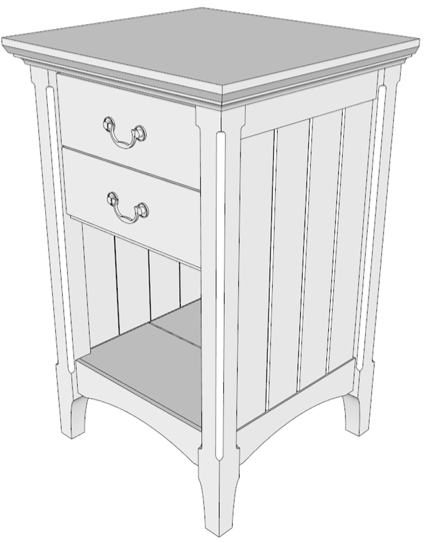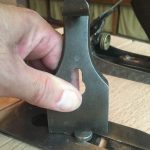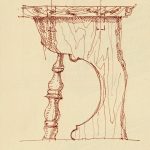We may receive a commission when you use our affiliate links. However, this does not impact our recommendations.
 Joe Zeh is a lifelong woodworker and an engineer with experience in the computer and graphics industry. He is author of “SketchUp: A Design Guide for Woodworkers” and also teaches SketchUp in video and live courses. This September Woodworking in America will feature two sessions by Zeh on the program and how to utilize it for woodworking. He was kind enough to spare a few moments from his busy schedule to answer a few questions.
Joe Zeh is a lifelong woodworker and an engineer with experience in the computer and graphics industry. He is author of “SketchUp: A Design Guide for Woodworkers” and also teaches SketchUp in video and live courses. This September Woodworking in America will feature two sessions by Zeh on the program and how to utilize it for woodworking. He was kind enough to spare a few moments from his busy schedule to answer a few questions.
You’ve been a woodworker for most of your life. How has SketchUp changed the way you approach your love of woodworking?
Early in my youth my projects would start with an image in my head and tools in my hand. I had no drawings to guide me. Needless to say, my prototype and my finished product were one in the same. Many changes were made along the way to account for things I didn’t think of. Material needs and final cost were known only after numerous trips to the lumber store and the last piece of material was purchased. Those early projects were more crude and rather simple compared to what I now tackle.
As time went on I wanted to build more complex pieces and so I began to draw sketches by hand, and later by 2D drawing on a drafting board. My woodworking improved somewhat, but not commensurate with the amount of work I had to put into sketches and drafting. Further, I was not gifted with sketching talent. My sketches were difficult to read. If more than a day or two passed from the time of sketching I could no longer interpret them. Plus, 2D drawings were helpful, but they didn’t make it easy to visualize a 3D object, nor did they serve as a prototype.
In the early 90s my professional career took a turn. I went from computer and microprocessor design to 3D chip design and driver development. My work taught me about 3D CAD (specifically AutoCAD and a much cheaper TurboCAD). Both were professional tools. AutoCAD was outside my budget for a hobby and TurboCAD had a slightly shallower learning curve. So from 1995 to 2007 I gave up my sketching pencil and drafting board and created all my designs in TurboCAD. Along the way TurboCAD became more and more expensive until it was beyond my budget. Fortunately, in 2007 I was introduced to SketchUp. The learning curve was much shallower than even TurboCAD and the price was right – free! By mid-2008 I not only mastered SketchUp but I was teaching it online. As a woodworker I found SketchUp invaluable. Here are some of the reasons why:
- Sketching and creating shop drawings in SketchUp is easy and quick. All of my projects begin in SketchUp.
- SketchUp models are actually prototypes. They can be viewed from any angle and any view e.g. an x-Ray view. Joinery problems are immediately visible. Making changes to correct them is easy and free (no wasted materials).
- Shop drawings are easy to create once the model is complete. Simply create scenes with dimensions and print the scenes at any scale factor, including full-scale.
- Full-scale printouts make great templates. I usually print a part full-scale on paper and attach self-adhesive plastic backing (either single or double-sided adhesive). Attaching the full-scale printout to plywood I can quickly create a template for the router or band saw.
- With a SketchUp model and a SketchUp extension you can automatically produce cut lists for rough lumber, dimensioned lumber and sheet goods. Your truly has written a SketchUp extension called CutList Bridge, which I use on every project.
- Some SketchUp cut list extensions (including mine above) permit exporting files to sheet optimizer programs such as CutList Plus fx.
- CutList Bridge and some other SketchUp extensions not only export files to CutList Plus fx for sheet optimization, but also permit exporting DXF files to sheet optimization and CNC code generation applications such as Cut 2D Pro.
- SketchUp has an internal rendering engine that permits you to texture a model with wood grain. For higher quality photorealistic images [such as the one below] you can purchase a rendering extension.

- Perhaps one of the most useful features of SketchUp is that it permits the importing, scaling and tracing of .jpg images. Most people these days have a smart phone with camera. If you take judicious face on images of an antique or other piece, along with some measurements, you can import those images into SketchUp and quickly create reproduction shop drawings.
SketchUp has changed my woodworking in so many ways. I design my own furniture, though often inspired by other’s pieces. My lack of artistry and sketching would make that nearly impossible without a tool such as SketchUp. SketchUp has made it possible for me to be creative while free to change a design as often as I wish before committing to milling. My design and shop time are now much shorter, and I never worry about whether a piece is too complex for my skills. With SketchUp I can break any complex piece down into simple pieces. Most of all, the program is still free, and fun!
What are you currently working on?
Over the last few years I built my own bed and subsequently two matching chests. To complete my bedroom set I needed two bedside tables that also matched the bed and chests. I already had the SketchUp drawings for the chests so designing the bedside tables was a snap. I even imported some of the chest’s components and re-sized them for the bedside table (re-purposing if you will). [A side view of the chest is shown below.]
I wanted to copy the curves, side slate design and chamfers. So re-purposing SketchUp components and resizing them was the way to go. [A SketchUp perspective view of the finished model is shown below.] I hope to have these pieces completed by my appearance at WIA. Anyone interested can download this and other of my models at my Popular Woodworking blog SketchUp With Joe Zeh.
You’re the author of the book “SketchUp: A Design Guide for Woodworkers.” Would mind talking a little about the work that went into that—and the work you do to keep it up to date?
 When I was first learning SketchUp in 2007 and early 2008, I bought all the books I could find. There weren’t many at the time – maybe three or four. But none of them were directed at woodworkers, which surprised me because I felt SketchUp was an ideal tool for woodworkers. Most of them did nothing more than introduce you to the tool icons and showed you how to build a seven face house (four walls, a floor and two faces of a roof).
When I was first learning SketchUp in 2007 and early 2008, I bought all the books I could find. There weren’t many at the time – maybe three or four. But none of them were directed at woodworkers, which surprised me because I felt SketchUp was an ideal tool for woodworkers. Most of them did nothing more than introduce you to the tool icons and showed you how to build a seven face house (four walls, a floor and two faces of a roof).
In 2008 I began writing SketchUp blog posts for my website; essentially teaching woodworkers how to use SketchUp to create shop drawings. I also began posting my own designs and making my SketchUp models available for free. Before I knew it I had enough material for a book. I decided I wanted to write the SketchUp book I felt was badly missing. Leading up to it’s release I updated the book numerous times to account for new SketchUp versions 7 through 2015. Now that “SketchUp: A Design Guide for Woodworkers” is released I am still updating it for 2016 and will no doubt do so for 2017. I maintain three web pages on my website and blog in support of the book: Book Overview, Support Page and Feedback Page. For example, on the support page you will find chapter-by-chapter downloads, sample SketchUp files and errata. I don’t require a password to enter these pages, so even if you haven’t purchased my book you can download sample SketchUp files for example. Since the book release I have generated a lot of new material and models.
What are you looking forward to most at Woodworking in America?
It’s hard to single out just one thing, but for sure I am looking forward to talking to fellow woodworkers, especially those who currently use SketchUp in their shop work, or who wish to learn SketchUp. I hope to make myself available for anyone who has a SketchUp problem and would like some help.
I am currently developing a SketchUp plugin called CabWriter to design custom cabinets and built-ins. So I would love to sit in on Nancy Hiller’s “The Art of Designing & Installing Built-ins.”
Beyond my SketchUp interests, I am a woodworker at heart and love woodworking. Christopher Schwarz is always a favorite of mine. And I intend to learn more about nails and their rightful place in woodworking history. I will be sure to visit Lie-Nielsen Toolworks booth and other tool manufacturers.
Don’t miss Joe Zeh at Woodworking in America, September 16-18. Click to learn more about WIA.
Here are some supplies and tools we find essential in our everyday work around the shop. We may receive a commission from sales referred by our links; however, we have carefully selected these products for their usefulness and quality.










